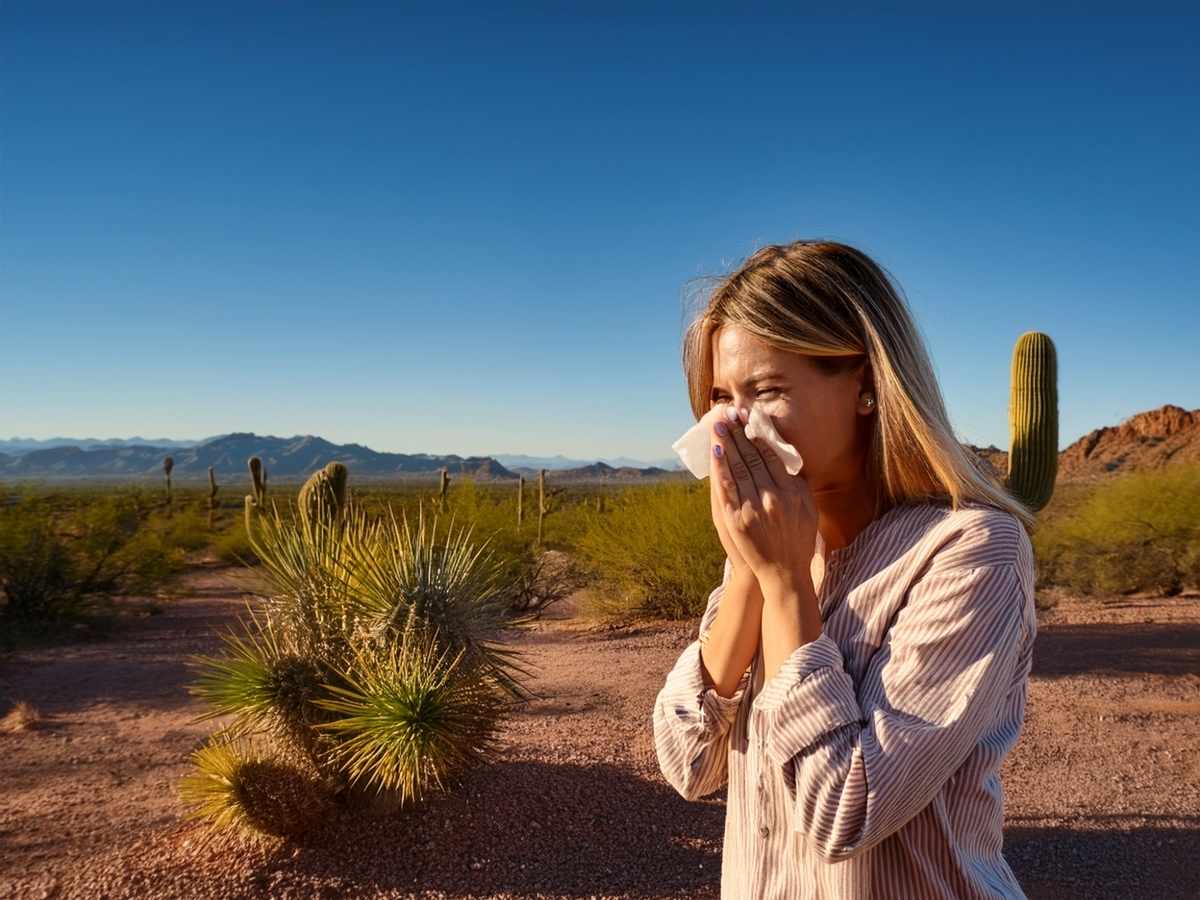Start your allergy season in Phoenix with preparation, not panic. For many newcomers moving to Phoenix, the dry desert air may feel like a welcome relief from seasonal allergies—at first. But what catches many off guard is that Phoenix brings its own unique set of allergens, and they’re not limited to spring. From year-round pollen to dust storms and desert blooms, understanding the allergy landscape in the Valley of the Sun is essential to staying comfortable and healthy.
Relocating to Phoenix often comes with the promise of clear skies and warm weather, but adjusting to the local environment means more than swapping winter coats for sunglasses. Newcomers should know that the Sonoran Desert has its own pollen-producing plants, micro-climates, and urban development patterns that contribute to surprising allergy symptoms. This guide is designed to help you get ahead of your first allergy season, with real insight into triggers, treatments, and trusted resources in Phoenix.
Understanding Phoenix’s Unique Allergy Triggers
Phoenix doesn’t follow the typical four-season allergy pattern that many newcomers are used to. Instead, allergy season in the desert is nearly year-round, with certain pollens spiking in waves based on plant cycles and weather patterns.
Spring in Phoenix often kicks off with tree pollens—especially from olive trees, mesquite, and mulberry. Despite city restrictions on planting certain high-allergen trees, older neighborhoods still have them, and their impact lingers. By summer, grasses like Bermuda and ragweed take over, causing itchy eyes and sneezing that can last into fall. Winter isn’t much of a break either, thanks to desert mold spores and indoor dust allergens.
One surprise for those relocating to Phoenix is how wind and dust storms, known locally as haboobs, can stir up allergens and irritants. These sudden events reduce air quality and increase exposure to pollen, dust mites, and airborne particles. It’s part of why allergy season in Phoenix doesn’t just hit once a year—it cycles with the environment.
Where to Get Tested: Allergy Clinics and Specialists
For newcomers who start experiencing unexplained symptoms—congestion, fatigue, coughing—it’s a smart move to get allergy tested. Phoenix offers several reputable clinics that specialize in desert-specific allergens and offer both skin and blood testing to identify your triggers.
Banner Health’s Allergy and Immunology team has locations across the metro area and offers comprehensive allergy testing with treatment plans tailored to Arizona’s environment. Their clinics are ideal for families moving to Phoenix who want care for both children and adults.
The Allergy Clinic at Mayo Clinic Phoenix is a trusted resource for those who may be managing more complex allergy issues or preexisting conditions. Mayo’s integrated approach means your care includes allergists, immunologists, and pulmonary specialists if needed.
Another go-to for allergy care is Arizona Allergy Associates, which has multiple Phoenix locations and offers everything from testing to immunotherapy shots. For newcomers unfamiliar with the desert’s unique allergens, their educational resources and long-term treatment plans can be a game-changer.
When to Prepare for Allergy Season in Phoenix
Start your allergy season in Phoenix before the symptoms start. Preparation is key—especially for those new to the area who might not know when things will hit. Spring allergies often begin in February, earlier than in most U.S. regions. That means newcomers should have medication, air purifiers, and a treatment plan in place by mid-winter.
Summer brings a wave of grass pollens, followed by fall allergens that surprise many who assume the season is winding down. With warm weather extending into November, ragweed and desert molds continue to linger. Even in December and January, cooler temps can mean increased indoor allergen exposure from dust and pets.
If you’re relocating to Phoenix in the fall or winter, don’t assume you’ve missed the worst. You may just be arriving at the start of a different cycle. Knowing what to expect and tracking the local pollen count through sites like Pollen.com or AirNow.gov can help you stay ahead of symptoms.
Tips for Managing Allergies Year-Round
Managing allergies in the desert is more than popping an antihistamine—it’s about creating a daily routine that keeps symptoms under control. For newcomers moving to Phoenix, these habits can make all the difference.
Investing in a HEPA air filter and vacuum can dramatically reduce indoor allergens. The dry climate means dust settles quickly, especially in older homes and rental properties. Swapping out fabric drapes for blinds, washing bedding weekly, and keeping windows closed during high pollen days are all small actions with big payoffs.
Over-the-counter options like Claritin, Zyrtec, or Flonase are widely available and effective for mild symptoms. However many locals turn to prescription treatments or immunotherapy if allergies become chronic. That’s where establishing care early—ideally before your first allergy season in Phoenix begins—is essential.
Staying hydrated is also critical in Phoenix, not just for heat but for allergy health. The dry air can dry out nasal passages, making you more susceptible to irritation and infection. Saline nasal sprays and humidifiers are popular tools for keeping symptoms in check without medication.
Natural Relief and Holistic Options
For those seeking alternative treatments, Phoenix offers a variety of holistic approaches to allergy relief. Southwest Integrative Medicine blends naturopathic therapies with traditional medicine, offering personalized plans that include herbal remedies, acupuncture, and dietary changes.
Unity Naturopathic is another option for newcomers who prefer a plant-based or homeopathic approach. Their allergy protocols often include immune-boosting supplements and detox programs that align with seasonal shifts in the desert.
Local honey is a popular home remedy that some believe helps build tolerance to regional pollen. While scientific support is mixed, it’s a low-risk option that many long-time residents swear by. Visit the Phoenix Public Market or Uptown Farmers Market to find locally sourced honey and support small businesses while exploring this natural remedy.
Pharmacies and Walk-In Clinics for Fast Relief
If symptoms flare suddenly, Phoenix has numerous pharmacies and clinics where newcomers can get quick relief. CVS MinuteClinics and Walgreens Healthcare Clinics are convenient for same-day access to allergy medications or steroid shots.
For a more targeted approach, HonorHealth operates urgent care locations throughout the city that handle respiratory and allergy-related complaints. These are great fallback options for those still in the process of finding a primary care physician after relocating to Phoenix.
Pediatric Allergy Care for Families
Families moving to Phoenix often have added concerns about how allergy season affects kids. Pollen, dust, and pet dander can trigger everything from runny noses to asthma flare-ups in young children, and the dry air can make symptoms worse.
Phoenix Children’s Hospital offers a full pediatric allergy and immunology department that’s highly regarded nationwide. They provide testing, treatment, and education for parents who are managing allergies in children—whether it’s seasonal hay fever or more serious food and environmental sensitivities.
Newcomers with children should also be aware that many schools participate in asthma and allergy readiness programs. Be sure to check with your child’s school nurse and notify them of any known allergies so accommodations can be made.
Environmental Triggers Beyond Pollen
Start your allergy season in Phoenix by understanding that it’s not just plants causing problems. The Valley’s environment creates multiple layers of allergen exposure that can affect even those who’ve never had allergies before.
Dust from construction zones, microplastics in air pollution, and monsoon humidity can all trigger symptoms. Even common landscaping choices—like oleander, palo verde, and fountain grass—can release irritants into the air that impact local neighborhoods differently. This makes some areas of Phoenix more allergy-prone than others.
Newcomers relocating to Phoenix should consider having their new home’s HVAC system cleaned or upgraded, especially if it’s older or hasn’t been maintained. Even something as simple as changing air filters monthly can drastically improve indoor air quality and help manage seasonal symptoms.
Start Your Allergy Season in Phoenix the Smart Way
If you’re thinking about moving to Phoenix, or you’ve already made the leap, don’t wait for allergy season to catch you off guard. The desert may seem dry and harmless, but beneath the surface, it’s filled with seasonal shifts, airborne triggers, and pollen producers that can challenge even lifelong allergy-free individuals.
Start your allergy season in Phoenix with a plan. Talk to a local specialist, monitor pollen counts, and make your home an allergy-safe zone. For newcomers, taking these steps early can mean the difference between enjoying the desert lifestyle and feeling overwhelmed by it.
Request your free Phoenix Relocation Guide here




